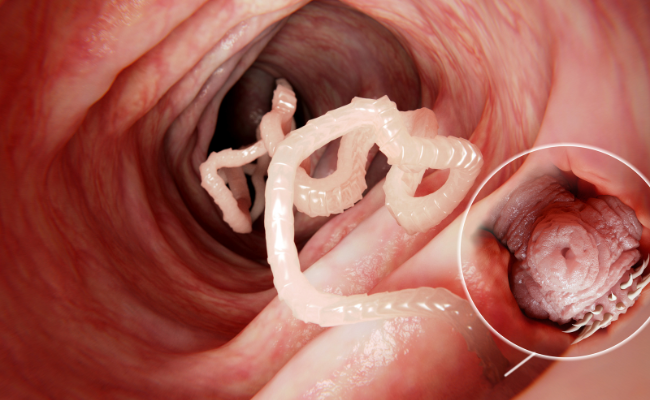How to Treat Tapeworms?
- December 15, 2023
- No Comments

What Are Tapeworms?
Tapeworms, classified as Cestoda, are flat, parasitic worms that thrive in the digestive tracts of humans and animals, exhibiting a segmented, ribbon-like structure ranging from a few millimeters to several meters. Notable species affecting humans include Taenia saginata (beef tapeworm), Taenia solium (pork tapeworm), and Hymenolepis nana (dwarf tapeworm). Their complex life cycle often involves intermediate hosts like cattle or pigs, emphasizing the need to understand their biology for effective treatment.
These parasites, once fully matured, anchor themselves in the host's intestines, absorbing nutrients for sustenance. The tapeworm's head attaches to the intestinal lining, while its body continues growing and producing eggs. These eggs exit the host through feces, completing a cycle that seeks new hosts, perpetuating the potential for infection.
Why Should Tapeworms be Treated?
The presence of tapeworms in the human body poses various health risks, making their treatment imperative. These parasites anchor themselves to the intestinal wall, absorbing nutrients from the host's digestive system. This can lead to malnutrition, weakness, and a range of uncomfortable symptoms. Common indicators of a tapeworm infection include abdominal pain, nausea, diarrhea, weight loss, and the presence of tapeworm segments or eggs in the feces. However, the implications go beyond these immediate symptoms. If left untreated, tapeworm infections can progress to more severe complications.
One such complication is cysticercosis, a condition caused by the larvae of the pork tapeworm, Taenia solium. In cysticercosis, the larvae form cysts in various tissues, including the brain, muscles, and other organs. This can result in neurological symptoms, seizures, and, in extreme cases, even death. Therefore, the timely and effective treatment of tapeworm infections is not only about alleviating immediate discomfort but also preventing the progression to more serious and potentially life-threatening conditions.
How to Identify Tapeworm Infections?
- Identifying tapeworm infections involves a combination of recognizing symptoms and conducting specific diagnostic tests. The symptoms, as mentioned earlier, include abdominal discomfort, nausea, changes in bowel habits, and unintentional weight loss. However, due to the nonspecific nature of these symptoms, a definitive diagnosis requires laboratory testing.
- The primary method for diagnosing tapeworm infections is through the analysis of stool samples. Microscopic examination can reveal the presence of tapeworm eggs or segments, providing clear evidence of the infestation. In some cases, imaging studies, such as X-rays or ultrasounds, may be conducted to detect the worms or cysts in the body. A thorough understanding of the patient's medical history, travel history, and lifestyle habits also plays a crucial role in the diagnostic process.
Treatment Solutions for Tapeworms
Medication:
- The cornerstone of tapeworm treatment is medication. Anthelmintic drugs, specifically praziquantel and albendazole, are commonly prescribed to eliminate the parasites.
- hese drugs work by disrupting the tapeworm's ability to absorb nutrients, leading to their eventual death.
- The dead worms are then expelled from the body through bowel movements.
The choice of medication and dosage depends on the type of tapeworm and the severity of the infection. It's essential for healthcare professionals to tailor the treatment to individual cases, taking into account factors such as age, weight, and overall health.
Deworming Protocols:
- Deworming protocols involve a systematic approach to eliminating tapeworms.
- Depending on the circumstances, treatment may consist of a single dose of medication or a series of doses administered over a specified period.
- The goal is to ensure complete eradication of the parasites from the digestive system.
The timing and duration of deworming protocols are determined by healthcare professionals based on the specific characteristics of the infection. Close monitoring and follow-up are essential to assess the effectiveness of the treatment and prevent recurrence.
Addressing Underlying Causes:
- Treating tapeworm infections is not only about eliminating the existing parasites but also addressing the factors that contribute to their transmission.
- Improving hygiene practices, ensuring the thorough cooking of meat, and promoting sanitation are crucial preventive measures.
In regions where tapeworm infections are more prevalent, public health initiatives play a vital role. Educational programs that raise awareness about the importance of hygiene, proper food handling, and the risks associated with undercooked meat contribute to the overall prevention of tapeworm infestations.
Benefits of Tapeworm Treatment:
- Relief from Symptoms: The most immediate benefit of tapeworm treatment is the relief from the uncomfortable symptoms associated with the infection. Abdominal pain, nausea, and digestive issues often improve as the medication takes effect, enhancing the overall well-being of the affected individual.
- Prevention of Complications: Timely treatment helps prevent the development of complications associated with tapeworm infections. By eliminating the parasites, the risk of more severe conditions like cysticercosis is significantly reduced. This not only protects the individual's health but also alleviates the potential burden on healthcare systems.
- Improved Nutritional Status: Tapeworms compromise the host's ability to absorb nutrients properly. Treatment restores this function, leading to improvements in nutritional status. Adequate nutrient absorption supports overall health, immune function, and energy levels.
- Reduced Transmission Risk: Treating tapeworm infections not only benefits the affected individual but also contributes to public health by reducing the risk of transmission. Proper sanitation, hygiene practices, and treatment play a crucial role in breaking the cycle of infection within communities.
Comments (0)